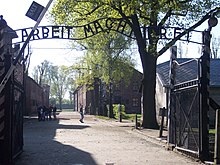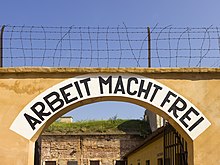Arbeit macht frei ([ˈaʁbaɪt ˈmaxt ˈfʁaɪ] ⓘ) is a German phrase translated as "Work makes one free" or more idiomatically "Work sets you free" or "work liberates".


The phrase originates from the 1873 novel Die Wahrheit macht frei ("The truth sets free") by Lorenz Diefenbach, a pastor and philologist, itself being a reference to John 8:31–32 of the Gospel of John. Following the Nazi Party's rise to power in 1933, the phrase became a slogan used in employment programs put into effect to combat mass unemployment in Germany at the time.[1] It is nowadays known for its use above the entrance of Auschwitz and other Nazi concentration camps.[2]
Origin
editThe expression comes from the title of an 1873 novel by the German philologist Lorenz Diefenbach, Die Wahrheit macht frei: Erzählung von Lorenz Diefenbach, in which gamblers and fraudsters find the path to virtue through labour.[3][4] "The truth will set you free" (Vēritās līberābit vōs) is a statement of Jesus found in John 8:32—"And ye shall know the truth and the truth shall make you free" (KJV).
The phrase was also used in French (le travail rend libre!) by Auguste Forel, a Swiss entomologist, neuroanatomist and psychiatrist, in his Fourmis de la Suisse (English: Ants of Switzerland) (1920).[5] In 1922, the Deutsche Schulverein of Vienna, an ethnic nationalist "protective" organization of Germans within Austria, printed membership stamps with the phrase Arbeit macht frei.[citation needed]
The phrase is also evocative of the medieval German principle of Stadtluft macht frei ("urban air makes you free"), according to which serfs were liberated after being a city resident for one year and one day.[6]
Use by the Nazis
editIn 1933, the first communist prisoners were being rounded up for an indefinite period without charges. They were held in a number of places in Germany. The slogan Arbeit macht frei was first used over the gate of the Oranienburg concentration camp,[7] which was set up in an abandoned brewery in March 1933 (it was later rebuilt in 1936 as Sachsenhausen).[8]
The slogan's use was implemented[when?] by Schutzstaffel (SS) officer Theodor Eicke at Dachau concentration camp.[9] From Dachau, it was copied by the Nazi officer Rudolf Höss, who had previously worked there. Höss was appointed to create the original camp at Auschwitz, which became known as Auschwitz (or Camp) 1 and whose intended purpose was to incarcerate Polish political detainees.[10][11]
The Auschwitz I sign was made by prisoner-laborers including master blacksmith Jan Liwacz, and features an upside-down 'B', which has been interpreted as an act of defiance by the prisoners who made it.[12][13][14]
In The Kingdom of Auschwitz, Otto Friedrich wrote about Rudolf Höss, regarding his decision to display the motto so prominently at Auschwitz:
He seems not to have intended it as a mockery, nor even to have intended it literally, as a false promise that those who worked to exhaustion would eventually be released, but rather as a kind of mystical declaration that self-sacrifice in the form of endless labor does in itself bring a kind of spiritual freedom.[15]
In 1938, the Austrian political cabaret writer Jura Soyfer and the composer Herbert Zipper, while prisoners at Dachau, wrote the Dachaulied or "The Dachau Song". They had spent weeks marching in and out of the camp's gate to daily forced labour, and considered the motto Arbeit macht frei over the gate an insult.[16] The song repeats the phrase cynically as a "lesson" taught by Dachau.
An example of ridiculing the slogan was a popular saying used among Auschwitz prisoners:
Arbeit macht frei |
Work makes you free |
It can also be seen at the Gross-Rosen, and Theresienstadt camps, as well as at Fort Breendonk in Belgium. At the Monowitz camp (also known as Auschwitz III), the slogan was reportedly placed over the entrance gates.[17][18] However, Primo Levi describes seeing the words illuminated over a doorway (as distinct from a gate).[19] The slogan appeared at the Flossenbürg camp on the left gate post at the camp entry. The original gate posts survive in another part of the camp, but the sign no longer exists.[20]
The signs are prominently displayed, and were seen by all prisoners and staff— all of whom knew, suspected, or quickly learned that prisoners confined there would likely only be freed by death. The signs' psychological impact was tremendous.[15]
Thefts of Arbeit macht frei signs
editThe Arbeit macht frei sign over the Auschwitz I gate was stolen in December 2009 and later recovered by authorities in three pieces. Anders Högström, a Swedish neo-Nazi, and five Polish men were jailed as a result.[21] The original sign is now in storage at the Auschwitz-Birkenau State Museum and a replica was put over the gate in its place.[22]
On 2 November 2014, the sign over the Dachau gate was stolen.[23] It was found on 28 November 2016 under a tarp at a parking lot in Ytre Arna, a settlement north of Bergen, Norway's second-largest city.[24]
See also
edit- Extermination through labour
- Jedem das Seine (idiomatically, "everyone gets what he deserves"), a motto used at the Buchenwald concentration camp.
References
edit- ^ "Arbeit macht frei". auschwitz.org. Retrieved 24 March 2024.
- ^ Encyclopedia of the Holocaust, Yad Vashem, 1990, vol. 4, p. 1751.
- ^ Connolly, Kate (18 December 2009). "Poland declares state of emergency after 'Arbeit Macht Frei' stolen from Auschwitz". The Guardian. Retrieved 1 October 2018.
- ^ Diefenbach, Lorenz (1873). Arbeit macht frei: Erzählung von Lorenz Diefenbach (in German). J. Kühtmann's Buchhandlung.
diefenbach arbeit macht frei.
- ^ Forel, Auguste (1920). "Les fourmis de la Suisse (2nd Ed.)" (in French). La Chaux-de-Fonds: Imprimarie cooperative. Retrieved 22 November 2010.
- ^ ""Stadtluft macht frei": Minister bedauert Irritationen" (in German). 26 March 2019. Archived from the original on 31 October 2019. Retrieved 8 August 2019.
- ^ Bartrop, Paul R.; Grimm, Eve E. (2022). The Holocaust: The Essential Reference Guide. Santa Barbara: ABC-CLIO. ISBN 978-1-4408-7778-0[pages needed]
{{cite book}}: CS1 maint: postscript (link) - ^ "Oranienburg Concentration Camp 1933–1934". Memorial and Museum Sachsenhausen. Brandenburg Memorials Foundation. 2014. Archived from the original on 20 July 2011. Retrieved 17 December 2014.
- ^ Marcuse, Harold (22 March 2001). Legacies of Dachau: The Uses and Abuses of a Concentration Camp, 1933-2001. Cambridge University Press. ISBN 9780521552042.
- ^ "Auschwitz: Inside the Nazi State . Auschwitz 1940-1945 . Surprising Beginnings | PBS". www.pbs.org. Retrieved 1 October 2018.
- ^ Laurence Rees, Auschwitz: a New History
- ^ "Auschwitz's sign of death and defiance". BBC News. Retrieved 23 April 2015.
- ^ "B - the sculpture". International Auschwitz Committee. Retrieved 23 April 2015.
- ^ a b "Arbeit macht frei - facts about Auschwitz gate". Krakow Direct. 5 July 2019. Retrieved 18 July 2019.
- ^ a b Friedrich, Otto (August 1994). The Kingdom of Auschwitz. Harper Perennial. pp. 2–3. ISBN 978-0-06-097640-8.
- ^ Zobl, Wilhelm; Zipper, Herbert (December 1988). "ÜBER DIE ENTSTEHUNG DES DACHAU-LIEDS". Österreichische Musikzeitschrift. 43 (12): 666. doi:10.7767/omz.1988.43.12.666. S2CID 164058102. Retrieved 8 August 2022.
- ^ Denis Avey with Rob Broomby The Man who Broke into Auschwitz, Hodder and Stoughton, London, 2011 p.236
- ^ Freddie Knoller with Robert Landaw Desperate Journey: Vienna-Paris-Auschwitz, Metro, London, 2002, ISBN 978-184-358028-7 p.158
- ^ Levi, Primo, trans. Stuart Woolf, If This Is a Man. Abacus, London, 2004, p. 28.
- ^ KZ-Gedenkstaette Flossenbuerg
- ^ "Former neo-Nazi jailed for Auschwitz sign theft". The Independent. Retrieved 1 October 2018.
- ^ "Auschwitz sign theft: Swedish man jailed". BBC News. 30 December 2010.
- ^ "Dachau infamous Nazi concentration camp gate stolen". BBC News. 3 November 2014.
- ^ "'No usable evidence' in investigation into stolen Dachau sign". Israel National News. 4 December 2016. Retrieved 1 October 2018.
External links
edit- Media related to Arbeit Macht Frei at Wikimedia Commons
- The dictionary definition of Arbeit macht frei at Wiktionary